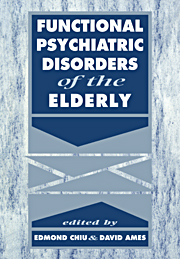Book contents
- Frontmatter
- Contents
- List of contributors
- Preface
- Introduction – A personal note
- Acknowledgement
- Part 1 Classification
- Part 2 General epidemiology
- Part 3 Neuroses
- Part 4 Affective disorders
- Part 5 Psychosexual disorders
- Part 6 Substance use and abuse
- Part 7 Schizophrenia and related psychoses
- Part 8 Psychological, biological and medical issues
- Part 9 Treatment methods
- 25 Geriatric psychopharmacology
- 26 Electroconvulsive therapy in later life
- 27 Family therapy
- 28 Group therapy in the elderly
- 29 Integrated psychotherapy of the elderly
- 30 Management of the treatment team in a multidisciplinary framework
- 31 Occupational therapy
- 32 Nursing management
- 33 Social work and the psychiatry of late life
- 34 Music therapy
- 35 Physiotherapy
- Part 10 Conclusion
- Index
25 - Geriatric psychopharmacology
from Part 9 - Treatment methods
Published online by Cambridge University Press: 13 November 2009
- Frontmatter
- Contents
- List of contributors
- Preface
- Introduction – A personal note
- Acknowledgement
- Part 1 Classification
- Part 2 General epidemiology
- Part 3 Neuroses
- Part 4 Affective disorders
- Part 5 Psychosexual disorders
- Part 6 Substance use and abuse
- Part 7 Schizophrenia and related psychoses
- Part 8 Psychological, biological and medical issues
- Part 9 Treatment methods
- 25 Geriatric psychopharmacology
- 26 Electroconvulsive therapy in later life
- 27 Family therapy
- 28 Group therapy in the elderly
- 29 Integrated psychotherapy of the elderly
- 30 Management of the treatment team in a multidisciplinary framework
- 31 Occupational therapy
- 32 Nursing management
- 33 Social work and the psychiatry of late life
- 34 Music therapy
- 35 Physiotherapy
- Part 10 Conclusion
- Index
Summary
Introduction
The elderly person is likely to experience many socioeconomic, emotional and physiological changes which will have a major bearing on psychotropic drug treatment. Such a population is therefore more likely to be exposed to more types of drug treatments than would be found in younger age groups. This often results in drug interactions (for example, hypotension associated with diabetes mellitus and tricyclic antidepressants). Other factors which complicate therapy include age related changes in the physiological status which may be reflected in pharmacokinetic features of the psychotropic medication (Greenblatt, Abernathy & Shader, 1986). Such changes in physiological factors are summarized in Table 25.1.
It has been found that the vast majority of elderly patients being treated for a psychiatric disorder also have at least one physical disorder that requires medication (Kennedy, 1992). Thus the elderly are the most likely group to experience adverse drug reactions and interactions. Studies show that patients over the age of 70 years have approximately twice as many adverse drug reactions as those under 50.
Another problem which particularly affects the elderly population concerns compliance with prescribed medication. Factors such as impaired vision, making it difficult for the patient to recognize the various medications, impaired hearing, manual dexterity and cognition all contribute to the noncompliance. Perhaps one of the most important factors that govern noncompliance is the increased frequency and severity of the side-effects that occur with most types of medication in the elderly.
- Type
- Chapter
- Information
- Functional Psychiatric Disorders of the Elderly , pp. 427 - 439Publisher: Cambridge University PressPrint publication year: 1994



